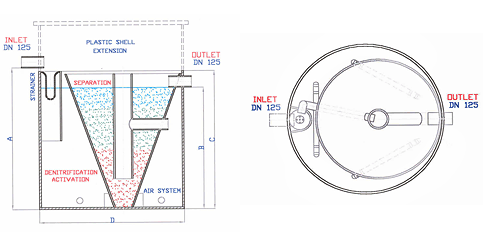DEOCOMMERCE LTD WASTEWATER TREATMENT
FOR HOMES AND COTTAGE
Domestic wastewater treatment plant
Application
The equipment is used for treatment of municipal wastewater for small sources, as houses, cottages and similar objects that are not connected to sewerage system. The treated wastewater arises from all sanitary facilities: WC, bathroom, washing machine, dishwasher etc. The domestic plants (type designation DC) are manufactured in the service range 2 to 25 persons.


Biological treatment principle
Biological process is applied for wastewater treatment in the domestic unit DC produce by Company ADOS. The basic process is life process of biomass represented by activated biological sludge. It is a mixture of microorganisms, which needs and process to lives matters contained in wastewater. In the course of the treatment process some secondary effects occur whet ammoniac (nitrification) and nitrates (de-nitrification) from water and removed. The purified water is separated from the activated sludge and is discharged through overflow to recipient while the activated sludge is returned to the beginning of the treatment process circuit. At setting the reactor into operation activated sludge from an existing operating plant is used. During the treatment process the microorganisms are reproduced and the activated sludge accumulates. The amount of sludge is maintained on optimal level and excess sludge is discharge from the reactor. In this process no chemical materials are used.
Design
The reactor of the plant consist of cylindrical plastic tank, conical separation structure and air-distribution system including air blower. The conical structure divides the reactor in two compartments: inlet (activation, de-nitrification) section and outlet section (secondary sedimentation). Wastewater flows into the activation section through inlet strainer where larger solids are caught. There is mixed with activated sludge. Microorganisms present in sludge affect the matters contained in wastewater and start the treating process. Water is separated from sludge in the final sedimentation compartment and is discharged through overflow and sludge is pumped by airlift pump back to the inlet section.
Benefits
• Reduced capital cost - Single integrated bioreactor concept reduces auxiliary equipment and built-up land requirement.
• Reduced operating and maintenance costs - The compact design, minimal amount of moving parts, modularity of construction and self-regulating hydraulics results in reduced supervision requirements, contributing to lower operating and maintenance costs.
• Nutrient reduction - High treatment efficiency includes biological reduction of nitrogen and phosphorus and reductions of BOD5 and TSS.
• Less excess sludge and stabilized - Low microbiological loading results in longer sludge age, significantly less excess sludge production, and its stabilization. After treatment for pathogens (in some cases directly) the sludge may be used as fertilizer.
• No odor - Aerobic conditions throughout the bioreactor and extended sludge age dramatically reduce the potential for odor. Plants can be located within populated areas without any effect.
• Hydraulic flexibility - Separation prism or cone shape not only allows other treatment processes to take place around it, but also facilitates superior hydraulic flexibility.
• Modular and flexible design - Ensures that plants meeting current needs can be quickly expanded if and when demands grow up. A variety of construction materials are used and plant components can even be retrofitted into existing tanks.
• Improved sludge dewatering - Extended sludge age improves its structure and mechanical dewatering characteristics.
БПК - Biochemical Oxygen demand for (Biological Oxigen Demand, BOD)
НВ – suspended solids

| Type | Num. of persons |
Load BSK5 kg/ден |
Capacity m3/day |
Power input kW |
Total weight kg |
Tank diameter /Tank height m |
number tanks ks |
Inlet level m |
Outlet level m |
| DC 4 | 2 - 5 | 0.12 - 0.30 | 0.4 - 1 | 0.09 | 200 | ф1.6x1.52 | 1 | 1.62 | 1.32 |
| DC 8 | 6 - 10 | 0.36 - 0.60 | 1 - 2 | 0.09 | 350 | ф2.1x1.62 | 1 | 1.72 | 1.42 |
| DC 12 | 11 - 14 | 0.66 - 0.84 | 1 - 2.8 | 0.12 | 350 | ф2.1x1.62 | 1 | 1.72 | 1.42 |
| DC 18 | 15 - 22 | 0.90 - 1.32 | 2.2 - 4.4 | 0.12 | 500 | ф2.3x2.02 | 1 | 2.12 | 1.82 |
| DC 25 | 23 - 26 | 1.38 - 1.56 | 2.2 - 5.2 | 0.24/0.55 | 500 | ф2.3x2.02 | 1 | 2.12 | 1.82 |
Installation instructions
• There are several important rules to be kept when installing the unit. Following these rules shall guarantee free operation and prevent possible damages caused by incorrect installation.
• The unit can be installed in cellar or under ground surface, e.g. in the garden. Difference of inlet and outlet levels has to be respected. If the inlet is in large depth under ground level, plastic extensions shall be used to situate the unit in sufficient depth. The level off underground water limits underground installations. If the level is too high, the plant can be damaged by upward hydrostatic pressure. The bottom of excavation shall be reinforced with concrete base plate. On the base plate the DC unit is placed and the foot is reinforced by the concrete ring.
• The installed unit shall be filled with water and in the same time is backfilled with bulk material (sand, soil).
• Furthermore you connect the unit to inlet and outlet tubes. Connect to the air source (blower). The blower should be placed in a place where is protected against weather attack. It can be installed in cellar of the house, or in the plastic extension. The length of the connecting air house should not be longer than 12 to 15metres.
• For safety reasons the working space of the reactor have to be covered with detachable cover, which can be fitted with safety lock. Removing the cover, you check good function of the plant and make periodical maintenance.
Standard warranty period is 2 years.
2016 © Deocommerce Limited. All rights reserved